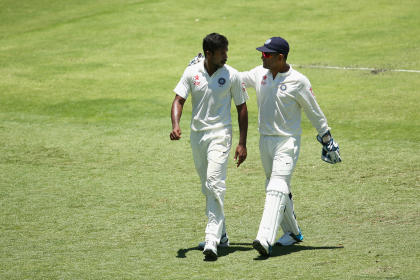Why Dhoni’s Test Retirement Is A Good Thing
In his shock retirement, Dhoni showed rare unpredictability that had been missing from his Test captaincy. But it was time for him to move on.

MS Dhoni led India in more Tests – 60 – than Gavaskar, Ganguly, Azharuddin. His 4876 runs and 294 dismissals are the most by a wicketkeeper from his country. Only Sehwag has hit more sixes than Dhoni’s 78. He was India’s most successful Test captain, but his record was diminished by years of strategic ineptitude. His safety-first tactics often helped him in one-day cricket but let him down heavily in recent Tests. It was time to go. India won’t play another Test till the end of an exhausting summer by when Dhoni would be touching 34.
Dhoni has had a large, unenviable workload of keeping, batting and captaining in nearly every game he’s played since 2008. Nobody else in cricket has pushed his body and mind through as much strain. He had turned grey quickly, though he rarely complained about the enormity of his tasks. By his own admission some months back, he had to retire from Tests to preserve himself for India’s World Cup defence.
Dhoni’s batting, his athleticism and reliability behind the wicket, and his captaincy were all on the wrong side of the bell curve. India could have eked out some more seasons from Dhoni the keeper, but Dhoni the Test captain had long hit his expiry date. It was a performance issue; he had it coming. Perhaps his fate was sealed in Adelaide where stand-in captain Virat Kohli took the refreshingly un-Dhoni-like approach of trying to win a game against steep odds.
Under him, India ranked No. 1 in Tests for the first time in 2009. The good run began to end on that fateful afternoon at Lord’s, 2011. Since then, India have lost 14 Tests out of 18 away from home, winning just one. It was not just the going away of India’s greats from Kumble to Sehwag, it was also the inability to get the best out of upcoming players.
Captains like Stephen Fleming and Arjuna Ranatunga had been able to nuddge players of middle-weight ability towards heavy-weight success. On the other hand, India have had the misfortune of seeing some incredible talents fade away with alarming consistency.

Incidents from the Melbourne Test can be cited as examples. On Day 3, Ryan Harris began with intent and aggression, persevering with a probing off-stump line. Backing him up were Australia’s brilliant fielding skills. Harris’ tight bowling and Haddin’s athletic catch resulted in Pujara’s wicket.
Contrast this with India’s opening over the next day. Umesh Yadav bowled two balls short and wide and got hit for fours. When he corrected his line, he got hit off the pads and conceded more runs. This complete lack of direction and intent, and the failure to dismiss tail-enders, has become a hallmark of Indian cricket. This was Dhoni’s problem to address, and he’s handled it poorly over a long time. Talented bowlers like Ishant Sharma, Varun Aaron and Mohammad Shami have joined the Indian team only to be reduced to punching bags. Dhoni must get his share of the blame for this.
Sourav Ganguly commented yesterday about Ravichandran Ashwin’s tendency to bowl middle and leg. Ganguly said he could be more effective with an outside-off line. Drifting to the leg, Ashwin has been able to neither attack nor contain. This had been a problem with Harbhajan as well. But Dhoni failed to fix it. It rendered Ashwin (and Harbhajan before him) ineffective.
Bear in mind, Ashwin is the bowler quickest to 100 Test wickets in nearly a hundred years. He knows how to take wickets. But he has failed completely against this Australian team that has very little idea about facing spin bowling. Good leadership fools mice into believing they are lions. What do India’s bowlers think they are? There's nothing lion-like about their performances. And who’s to blame for it? Dhoni? The coaching staff? Both?
It was only in the second innings in Melbourne when Dhoni was finally seen doing something about the bowling problem. “Ek hi jagah daalna (Bowl it on one spot)”, Dhoni told Umesh. And the bowlers obliged. Day 4 was India’s best bowling performance on the tour yet. The line and length was consistently good. They were genuinely unlucky to not have had more wickets. It seemed like a turn-around in Dhoni's methods. Little did we know it was the end.
Dhoni has earned his place among India’s cricketing pantheon. He’s still a magnificent one-day cricketer. One hopes this break from Tests reenergises him to put on one hell of a show at the World Cup. And may that be the thing we remember him by, not this streak of Test defeats.

 Yahoo Sport
Yahoo Sport 







































